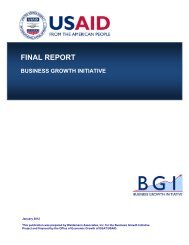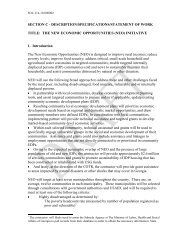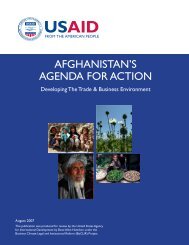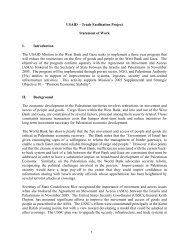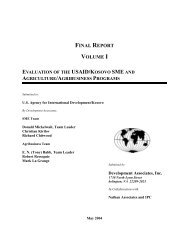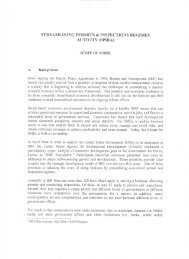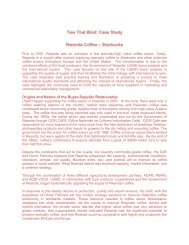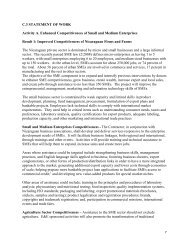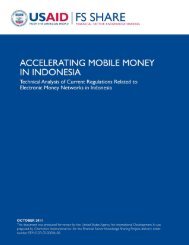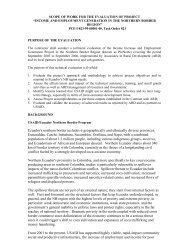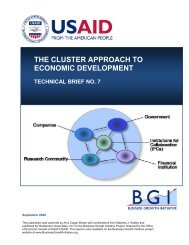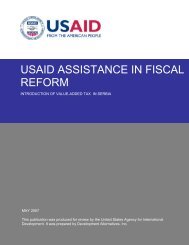Trade and Commercial Law Assessment - Honduras - Economic ...
Trade and Commercial Law Assessment - Honduras - Economic ...
Trade and Commercial Law Assessment - Honduras - Economic ...
Create successful ePaper yourself
Turn your PDF publications into a flip-book with our unique Google optimized e-Paper software.
TRADE AND COMMERCIAL LAW ASSESSMENT DECEMBER 2004HONDURASsubsidiary laws, regulations, <strong>and</strong> policies governing one or more of the areas addressed inthis report. For example, courts are usually a crucial institution in the examination ofCLIR. Problems uncovered often relate to bureaucratic inefficiency, lack of resources <strong>and</strong>training, <strong>and</strong>, of paramount concern, real or perceived corruption. With respect to theflow of goods, services, <strong>and</strong> people, Customs <strong>and</strong> Immigration authorities are the chiefimplementing institutions.♦♦Supporting Institutions. The <strong>Assessment</strong> then considers the environment oforganizations, individuals, or activities without which the legal framework or policyagenda cannot be fully developed, implemented, or enforced. Examples include notaries,banks, consumer groups, chambers of commerce, professional associations, <strong>and</strong> othersimilar ancillary service providers. Of particular interest with respect to supportinginstitutions is whether the institutions have any meaningful involvement in what the lawsays. Where there has been buy-in from affected constituencies, a law is more likely to beunderstood, to be used properly, <strong>and</strong> to achieve its purpose.Social Dynamics. Finally, the <strong>Assessment</strong> studies social dynamics, which entails askingwhether the affected constituencies of a law or policy perceive a need for change <strong>and</strong>, ifso, how they are demonstrating this need. For example, Are they effectively lobbyinginstitutions that can make a change? Are the media seizing the issue as a topic of publicconcern? Are individuals speaking out? On the other h<strong>and</strong>, have social dynamics taken aless positive approach (for example, is the “gray economy” growing in response toburdensome conditions for market entry)? Analysis of social dynamics can affect how anassistance project is ultimately designed. Where outside participation is strong <strong>and</strong> publicunderst<strong>and</strong>ing high, a reform program might involve a relatively small number ofgovernment officials who are capable of meeting the dem<strong>and</strong>s. In contrast, wheremistrust <strong>and</strong> misunderst<strong>and</strong>ing are abundant, an approach that involves significantengagement of “end users” will likely be necessary.C.SUMMARY OF SUBJECT-SPECIFIC FINDINGSBased on this multifaceted review process, reports for each area were completed <strong>and</strong> quantitativeindicators scored. It should be noted that some repetition of material occurs in the varioussections so that each chapter reads as a complete whole. The general findings in the 13 subjectmatter areas addressed in this report are as follows:♦Company <strong>Law</strong>. Although the <strong>Commercial</strong> Code in <strong>Honduras</strong> (i.e., the Honduran Code ofCommerce of 1950) is modern by regional st<strong>and</strong>ards, sections of the code remainoutdated. Specifically, the code does not provide for fully owned subsidiaries, requiresequity capital, <strong>and</strong> lacks mechanisms to protect minority shareholders <strong>and</strong> enforceprinciples of corporate governance. These issues keep private sector participants in<strong>Honduras</strong> from meeting their economic potentials, <strong>and</strong> should be addressed throughlegislative reform. In addition, a variety of institutional weaknesses, including the<strong>Commercial</strong> Registry, the courts, <strong>and</strong> the tax system, combine to deter foreign investment<strong>and</strong> domestic business growth on the margin, <strong>and</strong> encourage the trend toward operating inthe informal economy. Access to credit is scarce for formal businesses <strong>and</strong> nearlynonexistent for informal firms. The stock market, which could be used as an alternativeI-5



